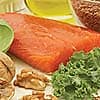
What's hot
What's hot
| News flashes are posted here frequently to keep you up-to-date with the latest advances in health and longevity. We have an unparalleled track record of breaking stories about life extension advances.
Olive leaf extract lowers blood pressure and cholesterol
The study population consisted of 20 sets of identical twins with mild hypertension. Twins from each pair were assigned to different treatment groups consisting of 10 subjects each in two experiments. The first experiment compared the effect of 500 milligrams olive leaf extract to a group that received lifestyle advice only. The second experiment compared a group that received 500 milligrams olive leaf extract per day to a group that received 1000 milligrams. Heart rate, blood pressure, weight, glucose, and lipids were measured at baseline and at several time points throughout the experiments. By the end of the treatment period, participants who received the high dose olive leaf extract experienced a significant decrease in mean blood pressure, while blood pressure remained unchanged in the control and low dose groups. Mean blood pressure declined from 137 mmHg in those that received 1000 milligrams olive leaf extract to 126 mmHg. Cholesterol levels decreased in those that received both the low and high dose olive leaf extract. When pairs of twins were compared, low density lipoprotein cholesterol was dose-dependently reduced among those that received olive leaf. Olive leaves contain oleuropein, which has been shown to have a vasodilatory effect in animal experiments. The compound also has high antioxidant activity, which may be responsible for some of its effects on cholesterol. The ability of olive leaf or other natural products to reduce blood pressure may be of value for those wishing to avoid the side effects of conventional antihypertensive drugs when lifestyle changes are insufficient. —D Dye Green tea polyphenol improves diastolic blood pressure and mood
Researchers from Great Britain sought to determine the effect of green tea on insulin resistance and metabolic risk factors in 88 overweight or obese nondiabetic men aged 40 to 65. Participants were randomly assigned to 400 milligrams EGCG or a placebo to be consumed twice per day for eight weeks. Glucose tolerance and metabolic risk factors, including blood pressure, were measured at the beginning and end of the treatment period. Mood was evaluated each week via a mood adjective questionnaire. Although EGCG supplementation was not associated with improvements in insulin resistance or most metabolic risk factors in this study, diastolic blood pressure declined by 2.68 mmHg among men who received the compound in contrast with a decline of 0.058 mmHg in the control group. Those who received EGCG also reported a more positive mood and were not as tense than the placebo group by the end of the study. The authors suggest that the effect of EGCG on blood pressure may play a role in some of the cardiovascular benefits that have been associated with the compound. EGCG has been shown to induce vasodilation in the arteries of rats, as well as stimulate the production of nitric oxide, a vasodilator, in endothelial cell cultures. Its effect on mood suggests that the compound may impact central nervous function, which may be mediated through gamma-aminobutyric acid receptors. The authors recommend further studies to explore the mechanisms of their findings. —D Dye Dark chocolate improves insulin sensitivity, blood pressure
Researchers at the University of L'Aquila in Italy randomized 11 men and 8 women to receive a daily regimen of 100 grams flavanol-rich dark chocolate or flavanol-free white chocolate for 15 days. This was followed by a one week period during which no treatment was received, and another 15 day period during which the treatments were switched between groups. Blood pressure, endothelial function, glucose tolerance, serum cholesterol, and C-reactive protein were assessed at the beginning of the study and at the end of each treatment period. Participants demonstrated significant insulin resistance and diminished insulin sensitivity upon enrollment, as determined by oral glucose tolerance and insulin testing. These conditions improved compared following the intake of flavanol-rich dark chocolate but were not improved by flavanol-free white chocolate. Systolic and diastolic blood pressure decreased following consumption of dark chocolate, and endothelial function, as evaluated by brachial artery flow-mediated dilation, improved. Additionally, dark chocolate was associated with reductions in total and low density lipoprotein cholesterol. Flavanols and related polyphenols may improve insulin resistance by increasing nitric oxide bioavailability in the endothelium and reducing reactive oxygen and nitrogen species. Because insulin resistance and impaired glucose tolerance are risk factors for diabetes and cardiovascular disease, and hypertension is also a cardiovascular disease risk factor, dark chocolate, along with other dietary components, could help contribute to the prevention of these common diseases. The authors conclude that their findings "suggest a potential value to developing flavanol-rich, low-energy cocoa foods, beverages, and supplements." —D Dye Higher serum vitamin E associated with reduced cataract risk
Researchers at the University of Medical Sciences and Health Services in Tehran, Iran measured vitamin A (retinol), vitamin C (ascorbic acid), and alpha-tocopherol (vitamin E) in the serum of 57 cataract patients and 31 healthy control subjects. All participants underwent physicals, including complete eye examinations. Serum vitamin A levels were not found to be significantly different between cataract patients and the control group. Serum alpha-tocopherol were significantly lower among those with cataracts, whose levels averaged 9.16 micrograms per milliliter compared with 13.26 mcg/mL in the control group. Serum vitamin C levels were also lower in the cataract group, however, the amount was not statistically significant. The finding adds evidence to previous studies which documented a relationship between higher serum alpha-tocopherol levels and decreased cataract development. Vitamin E's ability to inhibit lipid oxidation is the most common mechanism proposed to explain its protective effect on cataract development, however, the vitamin also helps to stabilize cell membranes and may play a role in ascorbate regeneration and glutathione recycling. The authors note that other nutrients and environmental factors have been found to play a role in cataract development, and encourage the intake of a diet containing abundant antioxidant vitamins. —D Dye Increased hip fracture risk observed among women with low vitamin D levels
The study involved postmenopausal participants in the Women's Health Initiative Observational Study, conducted at 40 U.S. clinical centers. Serum 25-hydroxyvitamin D levels were measured upon enrollment. Annual questionnaires completed by participants over a 7.1 year average follow-up period reported fracture occurrence and other information. The researchers compared 400 hip fracture patients with 400 age and ethnicity-matched controls. Obesity, frailty, and fair or poor health status decreased with rising vitamin D concentrations. A linear association was observed between declining vitamin D concentrations and increased hip fracture risk that did not appear to differ with age. Women with serum 25-hydroxyvitamin D levels in the lowest fourth of participants, at 47.5 nanomoles per liter or lower, had a 71 percent greater adjusted risk of hip fracture than those whose concentrations were highest at 70.7 nanomoles per liter or more. Vitamin D's protective mechanism may involve a reduction in bone resorption (as indicated in this study by lower C-terminal telopeptide of type 1 collagen levels) due to decreased parathyroid hormone concentrations in those with higher serum vitamin D levels. Additionally, having insufficient vitamin D can impair muscle strength and balance, leading to a greater risk of falling. "Our findings suggest that low serum hydroxyvitamin D concentrations might help identify women at high risk for hip fracture," the authors conclude. —D Dye Cocoa increases blood flow to brain
The researchers tested the effects of beverage containing high amounts of cocoa flavanols on participants between the ages of 59 and 83. Flavanols are compounds that naturally occur in cocoa which are believed to be responsible for many of its recently uncovered benefits. The investigators found an 8 percent increase in the participants' brain blood flow following one week of consuming the beverage, and a 10 percent increase after two weeks. The vascular benefits of cocoa have been demonstrated to be independent of the antioxidant effects found for cocoa flavanols. Previous research findings suggest that cocoa may benefit cardiovascular health as well as vascular complications associated with cognitive performance and skin health. "The totality of the research on cocoa flavanols is impressive, stated Harold Schmitz, PhD, chief science officer at Mars, Incorporated, which provided the materials used in this study. "This is just one more study adding to an increasing body of literature connecting regular cocoa flavanol consumption to blood flow and vascular health improvements throughout the body. "Though more research is needed, these findings raise the possibility that flavanol-rich cocoa products could be developed to help slow brain decline in older age." —D Dye Bone benefits diminish when calcium supplements discontinued
The researchers utilized data from the Calcium Polyp Prevention Study which sought to determine the effect of calcium supplements in men and women with a history of colorectal adenoma (polyps). Nine hundred thirty participants were randomized to receive 3 grams calcium carbonate providing 1200 milligrams elemental calcium per day or a placebo for four years. Blood samples obtained upon enrollment were evaluated for 25-hydroxyvitamin D, a metabolite of vitamin D that is used to evaluate vitamin D status. (Poor vitamin D levels increase fracture risk.) Eight hundred twenty-one subjects were followed after the end of the treatment phase of the trial for an average of 10.8 years, during which annual questionnaires obtained information on the use of calcium and other supplements, medication use, and fracture occurrence. Over the treatment phase of the study, fracture risk was 72 percent lower among those who received calcium. No fractures associated with minimal trauma (defined as occurring during a fall from a standing position or lower while standing or walking, but not running) were noted in the calcium group during the four year treatment period, while nine occurred in the placebo group. The effects were diminished after the end of the four year trial during the follow-up phase. "Calcium supplementation may be beneficial in the prevention of fractures among relatively healthy individuals who have close to adequate 25-hydroxyvitamin D concentrations and who are willing to take the supplements on a continuous basis," the authors conclude. —D Dye Outrunning death
Eliza F. Chakravarty, MD, MS, and colleagues at Stanford University School of Medicine mailed questionnaires to a group of runners and a healthy control group who were both aged 50 and older beginning in 1984. The groups completed yearly questionnaires concerning exercise frequency, disability level and body mass index through 2005. Data for 284 runners and 156 controls were available at the end of the study. National death records confirmed that 34 percent of the controls and 15 percent of the runners had died after 19 years. Deaths from cardiovascular disease, cancer, neurological disease, and other causes occurred earlier among the control group. Although disability in both groups increased over time, there was less disability among runners at all time points. "Runners' initial disability was 16 years later than nonrunners," noted senior author James Fries, MD, who is an emeritus professor of medicine at Stanford School of Medicine. "By and large, the runners have stayed healthy." "We did not expect this," he added. "The health benefits of exercise are greater than we thought." The authors attribute the benefits observed among the runners to increased cardiovascular fitness and improved aerobic capacity, greater bone mass, lower levels of inflammation, improved vaccination response, and better cognitive function associated with regular, vigorous exercise. Another finding, reported in the American Journal of Preventive Medicine, was that running is not association with a greater incidence of arthritis. "The study has a very pro-exercise message," Dr Fries concluded. "If you had to pick one thing to make people healthier as they age, it would be aerobic exercise." —D Dye Eating oily fish once per week cuts macular degeneration risk in half
For the current investigation, researchers in seven countries evaluated data from participants in the EUREYE study. Interview responses concerning type and frequency of fish consumption were analyzed to calculate the intake of the omega-3 fatty acids eicosapentaenoic acid (EPA) and docosahexaenoic acid (DHA). Fundus imaging of the eye was used to determine the presence of macular degeneration. One hundred five participants with wet macular degeneration were compared with 2,170 healthy control subjects. Oily fish, which contains high levels of EPA and DHA, was associated with a 50 percent lower risk of wet macular degeneration if consumed at least once per week compared with less than once per week. For participants whose EPA or DHA intake was in the top 25 percent at 300 milligrams per day or greater, there was a 70 percent lower risk of wet AMD compared with those whose intake was among the lowest 25 percent. "This is the first study in Europeans to show a beneficial association on wet AMD from the consumption of oily fish and is consistent with results from studies in the USA and Australia," announced lead researcher Astrid Fletcher, who is a Professor of Epidemiology at the London School of Hygiene & Tropical Medicine. "Two 3 ounce servings a week of oily fish, such as salmon, tuna or mackerel, provides about 500 mg of DHA and EPA per day," she observed. —D Dye Broccoli compound may counter diabetes damage
Previous studies have found associations between diets rich in vegetables, including broccoli and other members of the Brassica family, and a lower risk of cardiovascular disease. Professor Paul Thornalley of Warwick Medical School and his associates tested the effect of the compound sulforaphane, found in Brassica vegetables, on human microvascular endothelial cells incubated in low and high concentrations of glucose. They found that the compound reduced reactive oxygen species (a type of free radical whose levels can triple with elevated glucose) by 73 percent. It was also discovered that sulforaphane doubled the activation a protein known as nrf2, which protects tissues from oxidative stress by activating protective enzymes. Additionally, the compound prevented increased cellular accumulation and excretion of methylglyoxal, a substance that increases glycation. Glycation is the bonding of sugar and protein molecules which increases under conditions of elevated blood sugar, and which can also damage blood vessels. “Our study suggests that compounds such as sulforaphane from broccoli may help counter processes linked to the development of vascular disease in diabetes," Dr Thornalley commented. "In future, it will be important to test if eating a diet rich in Brassica vegetables has health benefits for diabetic patients. We expect that it will.” —D Dye Increased tocopherol intake associated with lower lung cancer risk
The current study compared 1,088 lung cancer patients with 1,414 age and smoking status-matched healthy controls. Dietary questionnaire responses concerning the year prior to cancer diagnosis or study enrollment were used to calculate individual tocopherol intake. While participants diagnosed with lung cancer had a lower body mass index and were more likely to have a history of emphysema than the control group, the control population was likelier to be better educated and use multivitamin/mineral supplements. Increased intake of alpha, beta and gamma-tocopherols was found to be associated with a reduced risk of lung cancer. When those whose alpha-tocopherol intake levels were among the highest 25 percent of all subjects' intakes were compared with those whose intake was in the lowest 25 percent, a 61 percent reduction in lung cancer risk was observed. For both beta-tocopherol and gamma-tocopherol, subjects whose intake was highest experienced a 44 percent lower risk compared to the lowest intake groups, however, this association that was reduced in a secondary model adjusted for intake of the other tocopherols and vitamin C. No significant association was observed between delta-tocopherol and lung cancer risk. To the authors knowledge, the investigation is the first to compare intakes of the different tocopherols and lung cancer risk. They suggest further research concerning the various forms of vitamin E and cancer risk. —D Dye Greater fish intake linked with reduction in silent brain infarcts
The study evaluated fish intake as reported in dietary questionnaires administered to 3,660 people age 65 and older. Participants received brain scans at the beginning of the study to detect to detect the small lesions known as silent brain infarcts that can reduce cognitive skills, in addition to leading to dementia or stroke. The scans were performed again on 2,313 of the subjects after five years. Participants who consumed broiled or baked tuna and other fish that contain high amounts of the omega-3 fatty acids EPA and DHA at least three times per week were found to have a 25 percent lower risk of silent brain infarcts than those who were not regular consumers. Eating this type of fish just once per week was associated with a 13 percent reduction. Additionally, regular high omega-3 fatty acid fish intake was linked with fewer white matter brain changes. "While eating tuna and other types of fish seems to help protect against memory loss and stroke, these results were not found in people who regularly ate fried fish," Dr Virtanen commented. "More research is needed as to why these types of fish may have protective effects, but the omega-3 fatty acids EPA and DHA would seem to have a major role." "Previous findings have shown that fish and fish oil can help prevent stroke, but this is one of the only studies that looks at fish's effect on silent brain infarcts in healthy, older people," she noted. —D Dye Increased alpha-linolenic acid intake linked with lower risk of nonfatal heart attack
In a study published in the July 22, 2008 issue of the American Heart Association journal Circulation, researchers at the Harvard School of Public Health, the University of Costa Rica, and Brown University age and gender-matched 1,819 men and women with a first nonfatal acute myocardial infarction (MI, or heart attack) to an equal number of control subjects. Adipose tissue samples and dietary questionnaire responses were analyzed for alpha-linolenic acid content, and the two groups were compared. Tissue levels of ALA reflected dietary intake levels of the fatty acid. The researchers found that alpha-linolenic acid intake as well as tissue levels were lower in those who had experienced an acute heart attack than in the control group. Subjects whose dietary ALA levels were in the top 10 percent of participants had a 39 percent lower heart attack risk than those whose levels were among the lowest 10 percent, and participants whose adipose tissue levels were highest experienced a 59 percent reduction. "Increased alpha-linolenic acid intake is associated with reduced risk of nonfatal acute MI," the authors conclude. "It is possible that consumption of vegetable oils rich in alpha-linolenic acid could confer important cardiovascular protection in many countries where intake is low." —D Dye |

 A report appearing in the September, 2008 issue of
A report appearing in the September, 2008 issue of  An article published online on August 19, 2008 in the
An article published online on August 19, 2008 in the  In a trial reported in the September, 2008 issue of the
In a trial reported in the September, 2008 issue of the  The latest issue of the
The latest issue of the  The August 19, 2008 issue of the
The August 19, 2008 issue of the  In a first-of-its-kind study published in the journal
In a first-of-its-kind study published in the journal  In the June, 2008 issue of the
In the June, 2008 issue of the  The August 11/25, 2008 issue of
The August 11/25, 2008 issue of  The August, 2008 issue of the the
The August, 2008 issue of the the  The high blood glucose levels that characterize
The high blood glucose levels that characterize  The August 5, 2008, issue of the journal
The August 5, 2008, issue of the journal  Alpha-linolenic acid (ALA) is a long-chain omega-3 fatty acid found in vegetable oils such as soy and canola, as well as other plant foods. While fish-derived omega-3 fatty acids eicosapentaenoic acid (EPA) and docosahexaenoic acid (DHA) have been demonstrated to have significant heart-protective benefits, evidence for alpha-linolenic acid has been less conclusive. However, due to the limited availability of fish or fish oil supplements for some populations, a plant-sourced omega-3 fatty acid could prove to be a useful alternative.
Alpha-linolenic acid (ALA) is a long-chain omega-3 fatty acid found in vegetable oils such as soy and canola, as well as other plant foods. While fish-derived omega-3 fatty acids eicosapentaenoic acid (EPA) and docosahexaenoic acid (DHA) have been demonstrated to have significant heart-protective benefits, evidence for alpha-linolenic acid has been less conclusive. However, due to the limited availability of fish or fish oil supplements for some populations, a plant-sourced omega-3 fatty acid could prove to be a useful alternative.